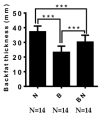Integrative Analysis of Transcriptomic and Lipidomic Profiles Reveals a Differential Subcutaneous Adipose Tissue Mechanism among Ningxiang Pig and Berkshires, and Their Offspring
- PMID: 37958077
- PMCID: PMC10647668
- DOI: 10.3390/ani13213321
Integrative Analysis of Transcriptomic and Lipidomic Profiles Reveals a Differential Subcutaneous Adipose Tissue Mechanism among Ningxiang Pig and Berkshires, and Their Offspring
Abstract
Adipose tissue composition contributes greatly to the quality and nutritional value of meat. Transcriptomic and lipidomic techniques were used to investigate the molecular mechanisms of the differences in fat deposition in Ningxiang pigs, Berkshires and F1 offspring. Transcriptomic analysis identified 680, 592, and 380 DEGs in comparisons of Ningxiang pigs vs. Berkshires, Berkshires vs. F1 offspring, and Ningxiang pigs vs. F1 offspring. The lipidomic analysis screened 423, 252, and 50 SCLs in comparisons of Ningxiang pigs vs. Berkshires, Berkshires vs. F1 offspring, and Ningxiang pigs vs. F1 offspring. Lycine, serine, and the threonine metabolism pathway, fatty acid biosynthesis and metabolism-related pathways were significantly enriched in comparisons of Berkshires vs. Ningxiang pigs and Berkshires vs. F1 offspring. The DEGs (PHGDH, LOC110256000) and the SCLs (phosphatidylserines) may have a great impact on the glycine, serine, and the threonine metabolism pathway. Moreover, the DEGs (FASN, ACACA, CBR4, SCD, ELOV6, HACD2, CYP3A46, CYP2B22, GPX1, and GPX3) and the SCLs (palmitoleic acid, linoleic acid, arachidonic acid, and icosadienoic acid) play important roles in the fatty acid biosynthesis and metabolism of fatty acids. Thus, the difference in fat deposition among Ningxiang pig, Berkshires, and F1 offspring may be caused by differences in the expression patterns of key genes in multiple enriched KEGG pathways. This research revealed multiple lipids that are potentially available biological indicators and screened key genes that are potential targets for molecular design breeding. The research also explored the molecular mechanisms of the difference in fat deposition among Ningxiang pig, Berkshires, and F1 pigs, and provided an insight into selection for backfat thickness and the fat composition of adipose tissue for future breeding strategies.
Keywords: KEGG pathways; lipidomic; pigs; subcutaneous adipose tissue; transcriptomic.
Conflict of interest statement
The authors declare no conflict of interest.
Figures













Similar articles
-
Analysis of transcriptome differences between subcutaneous and intramuscular adipose tissue of Ningxiang pigs.Yi Chuan. 2023 Dec 20;45(12):1147-1157. doi: 10.16288/j.yczz.23-131. Yi Chuan. 2023. PMID: 38764277
-
Differences in Immune Characteristics and Related Gene Expression in Spleen among Ningxiang, Berkshire Breeds and Their Hybrid Pigs.Genes (Basel). 2024 Feb 4;15(2):205. doi: 10.3390/genes15020205. Genes (Basel). 2024. PMID: 38397195 Free PMC article.
-
Effects of age on subcutaneous adipose tissue proteins in Chinese indigenous Ningxiang pig by TMT-labeled quantitative proteomics.J Proteomics. 2022 Aug 15;265:104650. doi: 10.1016/j.jprot.2022.104650. Epub 2022 Jun 8. J Proteomics. 2022. PMID: 35690344
-
Effect of Betaine Diet on Growth Performance, Carcass Quality and Fat Deposition in Finishing Ningxiang Pigs.Animals (Basel). 2021 Nov 29;11(12):3408. doi: 10.3390/ani11123408. Animals (Basel). 2021. PMID: 34944185 Free PMC article.
-
Identification of crucial modules and genes associated with backfat tissue development by WGCNA in Ningxiang pigs.Front Genet. 2023 Aug 17;14:1234757. doi: 10.3389/fgene.2023.1234757. eCollection 2023. Front Genet. 2023. PMID: 37662841 Free PMC article.
Cited by
-
Copy Number Variation and Selection Signal: Exploring the Domestication History and Phenotype Differences Between Duroc and the Chinese Native Ningxiang Pigs.Int J Mol Sci. 2024 Oct 31;25(21):11716. doi: 10.3390/ijms252111716. Int J Mol Sci. 2024. PMID: 39519268 Free PMC article.
-
Transcriptomics characteristics and differentiation of subcutaneous adipose tissue among Huainan pigs and its hybrid genetic populations.Front Vet Sci. 2025 May 22;12:1545694. doi: 10.3389/fvets.2025.1545694. eCollection 2025. Front Vet Sci. 2025. PMID: 40475027 Free PMC article.
References
Grants and funding
- NT2021005/Special Funds for the Laboratory of Lingnan Modern Agriculture Project
- 2021NK1009 and 2021NK1012/Special Funds for the Construction of Innovative Provinces in Hunan
- 2023JJ20043 and 2020JJ5635/the Natural Science Foundation of Hunan Province Project
- 2020JJB130030/the Natural Science Foundation of Guangxi Province
- No.ISA2023202/Open Fund of Key Laboratory of Agro-ecological Processes in Subtropical Region, Chinese Academy Open Fund of Key Laboratory of Agro-ecological Processes in Subtropical Region,Chinese Academy of Science
LinkOut - more resources
Full Text Sources
Miscellaneous

